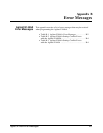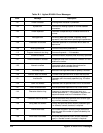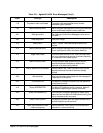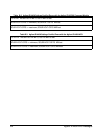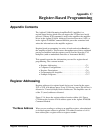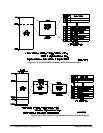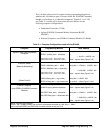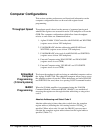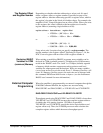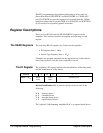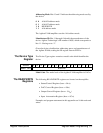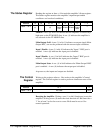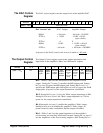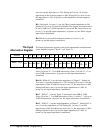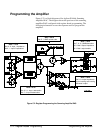
The Register Offset
and Register Number
Depending on whether absolute addressing or select code 8 is used,
either a register offset or register number is specified as part of the
register address. Absolute addressing specifies a register offset, which is
the register’s location in the block of 64 address bytes. For example, the
amplifier’s DAC Control Register has an offset of 08
16
. When you write
to this register, the offset is added to the base address to form the
register address (assuming a logical address of 88):
register address = base address + register offset
= 1FC000
16
+ (88 * 64)
16
+ 08
16
= 1FC000
16
+ 1600
16
+ 08
16
= 1FD608
16
or
= 2,080,768 + (88 * 64) + 8
= 2,080,768 + 5632 + 8 = 2,086,408
Using select code 8 requires that you specify a register number. The
register number is the register offset/2. Referring to Figure C-1A, the
DAC Control register with an offset of 08 is register number 4.
Declaring IBASIC
Variables in COM
(common) Memory
When writing or modifying IBASIC programs, array variables can be
declared in COM (common) memory. Variables not in COM memory
reside in the IBASIC stack. The ’stack’ is a 32 kByte (default) segment
of memory which contains components such as pointers and local
variables for subprograms and declarations. When too many variables
(or too large an array) are in the stack, Error 2 - Memory Overflow will
occur. If a memory overflow occurs, the stack size can be changed with
the command PROGram:MALLocate < nbytes> (see the Instrument
BASIC user’s manual for more information).
External Computer
Programming
When the amplifier is programmed by an external computer through the
E1405/06 Command Module, the registers are accessed using
DIAG:PEEK? and DIAG:POKE, or VXI:READ? and VXI:WRITE.
DIAG:PEEK?/DIAG:POKE and VXI:READ?/VXI:WRITE
Throughput speed using DIAG:PEEK? and DIAG:POKE is faster than
VXI:READ? and VXI:WRITE because the complete register address
(including the A16 starting location 1FC000
16
) is specified.
VXI:READ? and VXI:WRITE specify the device logical address and
register offset only. Thus, the E1405/06 processor must calculate the
complete register address which decreases throughput speed.
Computer Configurations Register-Based Programming C-5



